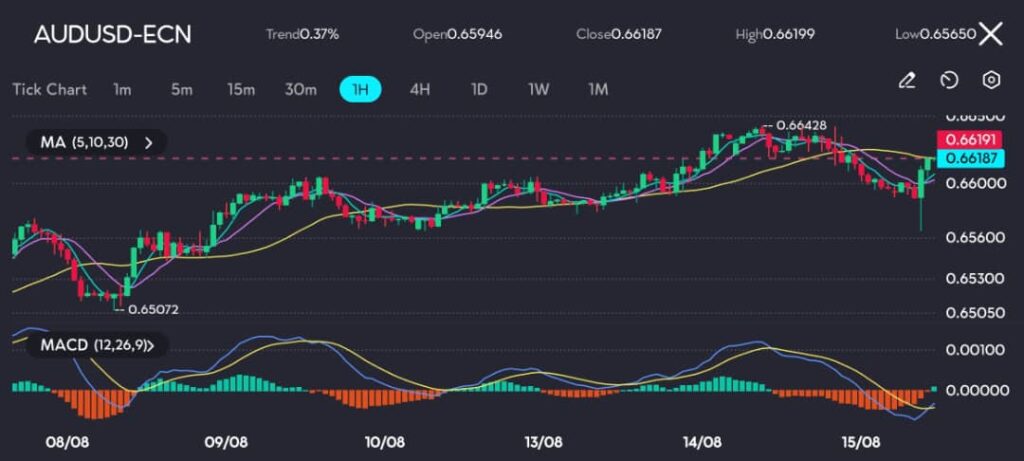Key points:
- The Australian dollar climbed to $0.6609 after stronger-than-expected job growth, despite a slight rise in the unemployment rate.
- The New Zealand dollar remained weak at $0.5990 as markets priced in further rate cuts from the Reserve Bank of New Zealand.
The Australian dollar (AUD) experienced a modest uplift on Thursday, touching $0.6609, following an unexpected surge in employment figures. The 58,200 jobs added in July far surpassed market forecasts of a 20,000 gain, indicating a resilient labour market despite broader economic challenges.

See: Aussie on the rise as seen on the VT Markets app.
Looking at the technical aspect, the 1-hour chart for AUDUSD shows a modest upward trend with the price closing at 0.66187 after opening at 0.65946. The chart highlights a recent high of 0.66428 before a slight pullback.
The Moving Averages (5,10,30) indicate a short-term bullish trend, while the MACD histogram shows a potential bullish crossover with the MACD line rising towards the signal line. This suggests the possibility of renewed upward momentum.
However, the price dipped to a low of 0.65650 during the session, indicating some volatility. Traders may be looking for a break above the recent high of 0.66428 to confirm further bullish sentiment.
Labour market strength reduces likelihood of near-term rate cuts by the RBA
This robust labour market data reinforces the Reserve Bank of Australia’s (RBA) stance against rate cuts in the near term, especially given persistent inflationary pressures. Market participants adjusted their expectations accordingly, reducing the likelihood of a November rate cut to 44%, down from 56% prior to the release of the jobs report.
Despite this, a quarter-point easing in December remains nearly fully priced in, driven partly by global trends, including potential rate cuts by the Federal Reserve.
In contrast, the New Zealand dollar (NZD) has been under pressure, remaining pinned at $0.5990. The Reserve Bank of New Zealand’s (RBNZ) decision to cut interest rates to 5.25%—a year ahead of its earlier projections—has spurred market speculation about further easing.
Swaps are currently pricing in an additional 73 basis points of cuts over the RBNZ’s October and November meetings, suggesting a possible half-point reduction at one of them.
In case you missed: Australian dollar faces resistance while kiwi advances awaiting rate decision
Australian dollar faces mixed outlook amid strong jobs data
For the Australian dollar, the strong job market could keep the Reserve Bank of Australia from cutting interest rates in the near future. This could provide some support for the currency in the short term. However, there are challenges ahead.
The drop in iron ore prices, Australia’s biggest export, could limit further gains for the Australian dollar. If the global demand for iron ore continues to weaken, it may put pressure on the currency despite the strong labour data.
New Zealand dollar under pressure as further rate cuts and slowing growth loom
On the other hand, the New Zealand dollar is facing more difficulties. The recent interest rate cut by the Reserve Bank of New Zealand, with more cuts likely on the way, is weighing heavily on the kiwi.
If the economic data continues to show signs of slowing growth, the central bank might take more aggressive steps to ease monetary policy. This could lead to further weakness in the New Zealand dollar as investors anticipate lower returns.
Both currencies are subject to global economic influences, particularly from the US Federal Reserve’s policy decisions, which could shift market dynamics significantly in the coming months.Start trading now — click here to create your live VT Markets account.









